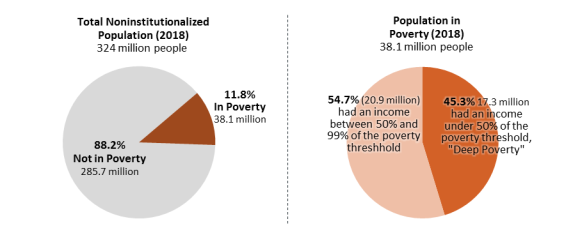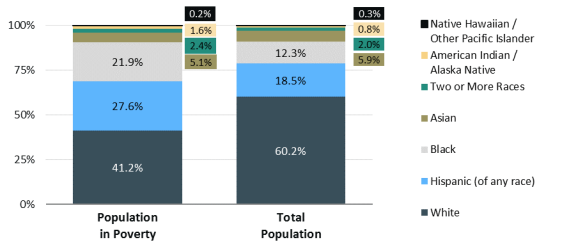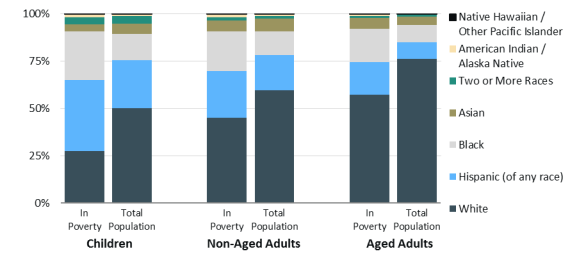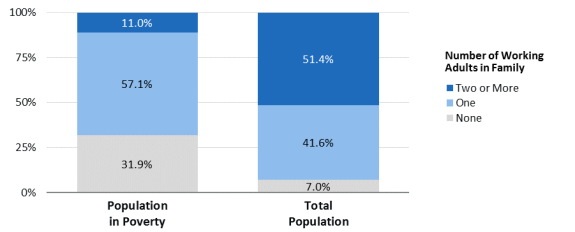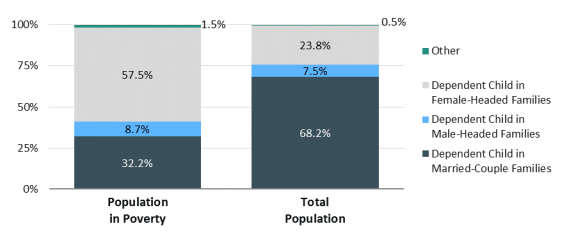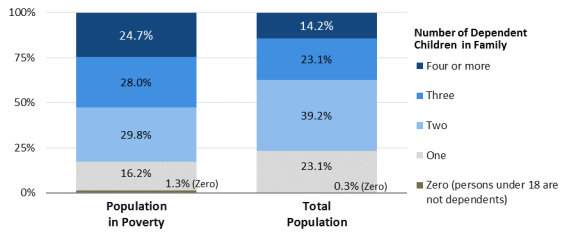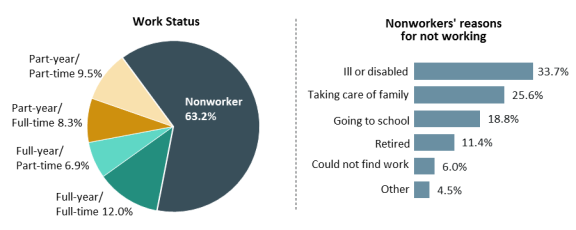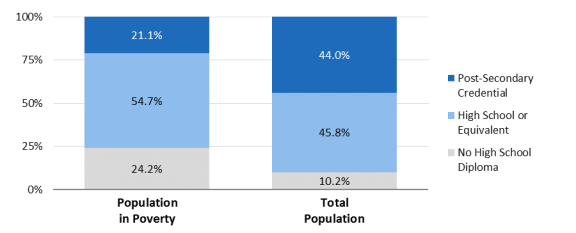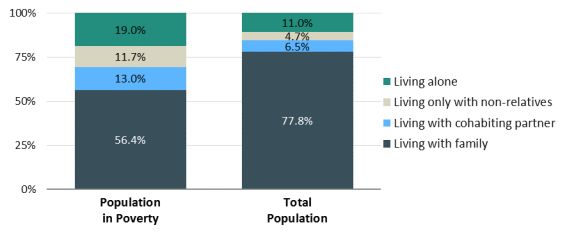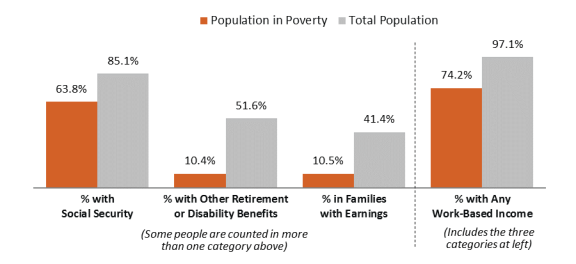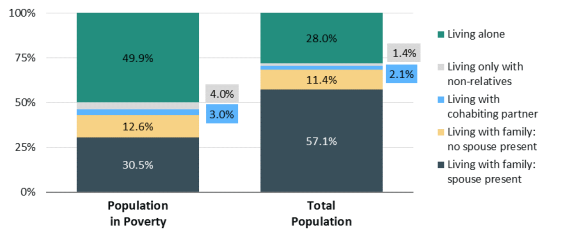Introduction
Poverty is an ongoing topic of interest for Congress, in various capacities: as a factor to be considered when allocating funding for certain programs, as an eligibility criterion for some low-income assistance programs, and to gauge the well-being of individuals, families, or the economy as a whole.1 The poverty rate fell to 11.8% in 2018 from 12.3% in 2017. In both years, the poverty rate was lower than the pre-recessionary level of 12.5% in 2007. However, since the end of the Great Recession in 2009,2 the poverty rate remained elevated for approximately the first four years after the recession's end, and despite reductions in the poverty rate in recent years, it remains higher than its record-low of 11.1% in 1973. Poverty's persistence alongside indicators of economic strength has led policymakers to continually examine the drivers of poverty—both economic and social—and the effectiveness of various policy responses. As the conversations about poverty and public policy continue, it may be useful to consider the question: Who are the people who are poor in the United States?
This report provides a snapshot of who was poor in 2018 by selected demographic, economic, and social characteristics. The data presented here show that people in poverty are not a monolithic group, but rather a diverse collection of families and individuals at different stages of life, living in different circumstances. Special attention is paid in this report to the role of work in the lives of people who are poor. Income from work, or the lack thereof, is central to the economic fortunes not only of those considered "working-age," but also of children, who are generally dependent on working-age adults, and persons who are aged (age 65 and older), who generally have prior experience in the workforce that shapes their economic well-being after they retire. Attention is also paid to living arrangements. Because poverty is measured at the family level, considerations such as whether someone lives alone, or whom someone lives and potentially shares resources with, influence economic well-being. Other factors that affect family well-being, and that influence individuals' attachment to and success in the labor market, are important for considering individuals' experiences of poverty but are beyond the scope of this report.
This snapshot looks at the composition of people in poverty—what groups comprise what share of the poverty population—rather than at poverty rates among different groups. This provides a different perspective in viewing poverty. A large population group such as non-Hispanic whites might have relatively low poverty rates, but because of the group's size in the overall population it represents a relatively large share of the poverty population. A small population, such as American Indians and Alaska Natives, might have relatively high poverty rates, but because of the group's size it represents a relatively small share of the poverty population. Both perspectives on poverty are valid and relevant to public policy. Readers interested in an examination of poverty rates for different demographic groups—and trends in poverty over time—should see CRS Report R46000, Poverty in the United States in 2018: In Brief, by Joseph Dalaker.
Data Used in this Report
Poverty, in general, is a lack of resources to meet basic needs. This report uses the official measure of poverty used by the U.S. Census Bureau to identify individuals as "poor."3 However, it is important to note that the Census poverty measure is actually family-based. Whether a person is considered poor depends on his or her money income and the income of any other family members—those related to a family head by birth, marriage, or adoption—with whom the person lives and presumably shares resources. If an individual is living alone or with people who are not relatives, that individual is considered a family of one and only his or her income is counted in determining his or her poverty status. That money income is then compared with a dollar threshold, which is based on that individual's family composition. For example, the poverty threshold for a working-age single person (who does not live in a family) in 2018 was $13,064. A single person with income below that amount is considered poor. The poverty threshold for a family of two adults and two children was $25,465. If the combined income of all family members was below that amount, all people in that family would be considered poor.4
The current official poverty measure has existed for about 50 years and is widely used, but it does have limitations. For example, the official measure looks only at pre-tax money income and does not examine the impact of government taxes and non-cash benefits on family well-being. The official measure also generally does not take the value of assets into account, though a recent change in measurement now considers distributions from retirement savings as income. The official measure is also the same across the country, and does not take into consideration differences in living costs in different geographical areas. Additionally, the measure's current definition of family does not take into account modern resource-sharing arrangements, such as those of cohabiting couples. The Census Bureau now publishes a supplemental poverty measure (SPM) for research purposes5 that does take into account taxes and transfers, make adjustments for housing costs by geographical area, and use an expanded definition of family.6
How Many People Were Poor in 2018?
In 2018, an estimated 38.1 million people had pre-tax money income below the poverty threshold. As shown in Figure 1, people who were poor accounted for 11.8% of the total noninstitutionalized population.7
The number and percentage of people in poverty reflect those whose family income fell short of the poverty threshold by any dollar amount. Of course, some people are poorer than others. One area of policy focus has been on the very poor: those considered to be in "deep poverty." Deep poverty is usually defined as having income below 50% of the poverty threshold. In 2018, an estimated 17.3 million persons, close to half of all people in poverty (45.3%), were counted as living in deep poverty.
Who Was Poor in 2018? An Overview
The population of people living in poverty comprised individuals of all ages and sexes, and across all racial and ethnic groups.8
Age
Figure 2 shows the composition of the population living in poverty and the overall population (for context) by age group in 2018. Three categories are presented: children (those under age 18), working-age adults (those ages 18 to 64), and the aged (those age 65 and older).
As shown in the figure, slightly less than one-third (11.9 million) of all people in poverty were children. Children were over-represented among people in poverty relative to the overall population—31.1% compared to 22.6%. People who were working age (18-64) made up the largest share of the population who were poor, but they were under-represented among people in poverty relative to the overall population (55.4% compared to 61.1%). Among persons who were poor, 13.5% were age 65 and older, a smaller representation than their share of the overall population (16.3%).
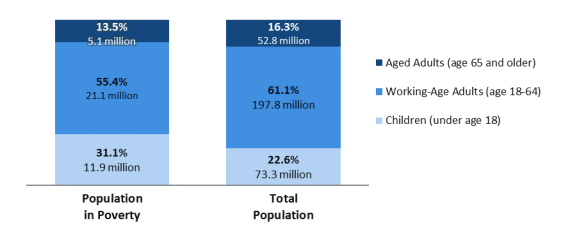 |
|
Source: Congressional Research Service (CRS) tabulation of data from the U.S. Census Bureau, Current Population Survey, 2019 Annual Social and Economic Supplement. |
Race and Ethnicity
Figure 3 shows the composition of people in the poverty population and the total population (for context) by race and ethnicity for 2018. The racial and ethnic groups presented are ranked by the size of their total population (which is the same in both cases). Non-Hispanic whites were the largest racial/ethnic group overall (60.2% of the total population), and represented the largest racial/ethnic group within the poverty population (41.2%). Hispanics (of any race) were the second largest group (18.5% of the total population) and represented 27.6% of all those who were poor. Non-Hispanic African-Americans were the third largest racial/ethnic group in both the total and poverty populations, representing 12.3% and 21.9%, respectively.
Note that most minority groups were over-represented in the poverty population relative to their share of the overall population. The over-represented groups were Hispanics, non-Hispanic African-Americans, and non-Hispanic American Indians and Alaska Natives.9 Under-represented racial/ethnic groups were non-Hispanic whites and Asians.
The racial and ethnic composition of people in poverty by age group is shaped by the overall demographic trends affecting each age group. As illustrated in Figure 4, children (under age 18), both poor and overall, are more racially and ethnically diverse than adults, especially the aged (age 65+). However, minorities were over-represented in the poverty population for all age groups in 2018. For instance, Hispanic children (of any race) made up the largest share of poor children (37.4%) whereas non-Hispanic white children made up the largest share (50.0%) of children overall.
Sex
Women slightly outnumber men in the overall population, accounting for 51.0% of the total population in 2018. However, as shown in Figure 5, women represented an even larger share (56.0%) of the population in poverty. This over-representation may be due, in part, to the fact that women are more likely than men to head single-parent households, a family type that is more likely to be poor.10 Additionally, men's earnings are higher than women's on average, even accounting for differences in full-time year-round employment status.11
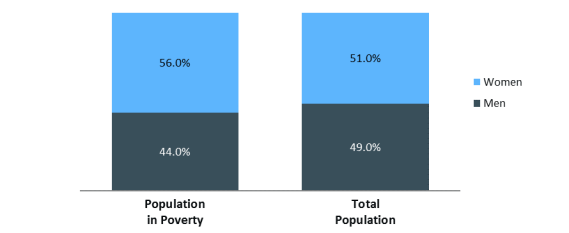 |
|
Source: Congressional Research Service (CRS) tabulation of data from the U.S. Census Bureau, Current Population Survey, 2019 Annual Social and Economic Supplement. |
Poverty Among Children, Working-Age Adults, and Aged Adults
Poverty raises different public policy considerations for children, working-age adults, and aged adults. Children are not expected to support themselves economically—they are dependents of their parents or other adult caretakers who are assumed to fulfill that responsibility. Policies affecting the family income and poverty status of children generally apply to their parents or other adult caretakers. Working-age adults—aside from those who are severely disabled—are expected to work and to support themselves and their children, if they have any. Aged adults may retire from work and draw income from public or private benefits, which are based primarily on their past work.
The remainder of this report separately explores poverty among children, working-age adults, and aged adults. Though relevant policy considerations may differ among the three groups, the central role played by work as the primary means of economic support for individuals and families is highlighted. That work could be one's own work, the work of the parents or other family members, or past work providing retirement income. Similarly, because poverty is a family-based measure and the ability to share resources is an important consideration in economic well-being, living arrangements are also explored.
Children
As noted earlier, children made up slightly less than one-third of all people in poverty in America in 2018, even though they made up less than a quarter of the total population. Thus, children in America are disproportionately poor. Of the three age groups examined in this report, children had the highest poverty rate in 2018, 16.2%.
Children rely on their parents or other adult caretakers for their support. That support, even for children who are poor, is likely to come from earnings from the work of their parents or other adult caretakers.
Figure 6 shows the composition of children who were poor and children in the total population by number of adult workers in the family for 2018. Note that the number of adult workers can exceed two, as it would include all adults in the family (such as siblings older than 18, grandparents, or other relatives over the age of 18). The figure shows that among children in the total population, 93.0% lived in families with at least one adult worker and roughly half (51.4%) lived in families with two or more adult workers.
Among children who were poor, just over two-thirds lived in families with one or more workers. A majority of children in poor families (57.1%) lived in families with one worker, compared with 11.0% who lived in families with two or more workers. The remaining 31.9% lived in families with no workers.
The number of potential adult workers in a child's family is affected by the type of family a child lives in. A single parent family might have only one potential adult worker, while a married-couple family has at least two potential adult workers.
Figure 7 shows the distribution of children who were poor and children in the total population by family type in 2018. Children living in female-headed families accounted for a majority (57.5%) of all children who were poor, a disproportionate share relative to children in the total population. However, children in married-couple families still accounted for nearly one-third (32.2%) of all children who were poor.
Despite a relatively low poverty rate for children in married-couple families in 2018, the large size of this population overall (children in married-couple families accounted for over two-thirds of all children) meant that a substantial number of children who were poor lived in this family type. Married-couple families were the only family type that was significantly under-represented among the population of children in poverty relative to the overall population.
Children who are poor are also more likely to live in larger families. Larger families require more income to meet needs, and thus the poverty thresholds for larger families are higher than for small families. However, since most children live in families with earnings, and earnings are not determined by family size—they are determined by what the worker can command in the labor market—larger families are more likely to be poor.
Figure 8 shows the composition of children who were poor and children in the overall population by number of children in the family in 2018. In that year, 24.7% of all children who were poor were in families with four or more children, which is disproportionately higher than the 14.2% of children in the overall population living in families of that size. In contrast, 46.0% of children who were poor were in families with only one or two children.
Working-Age Adults
The majority of people in poverty in America are working-age adults (18-64 years old). This age group represented 55.4% (21.1 million individuals) of all people in poverty in 2018. Overall, this age group had a poverty rate of 10.7%, a lower rate than that of the overall population.
Because poverty is a state of low income, and income generally comes from work, it is useful to explore the work status of working-age adults who are poor. In the overall population of working-age adults, the majority (77.3%) worked in 2018. However, among working-age adults who were poor, the majority (63.2%) did not work.
As shown in Figure 9, 36.8% of working-age adults who were poor were working in some capacity, either full- or part-time, full- or part-year. However, a relatively small share (12.0%) of working-age adults who were poor worked full-time all year.
When working-age adults, both the poor and those in the overall population, were asked why they were not working, a wide range of reasons were given. Of non-working adults who were poor, one-third reported being ill or disabled, one-fourth reported taking care of family members, 18.8% said they were going to school, 11.4% said they were retired, and 6.0% said they could not find a job. For those not working in the overall population, a greater proportion (16.2%) reported being retired and a smaller proportion (27.1%) reported being ill or disabled.
A large body of research has shown that success in the workforce is related to educational attainment.12 Credentials indicating higher levels of education tend to be reflected in higher earnings and steadier work. Figure 10 shows both working-age adults who were poor and all working-age adults by educational credential. The largest group (54.7%) of poor working-age adults in 2018 were those who obtained a high school diploma but no post-secondary educational credential. (High school graduates without a post-secondary credential were also the largest group (45.8%) within the total population of working-age adults.) Those lacking a high school diploma accounted for another 24.2% of all poor working-age adults, more than twice the share represented in the overall population (10.2%). The remaining 21.1% of 18 to 64 year olds below poverty had some postsecondary credential; the corresponding figure for all 18 to 64 year olds was 44.0%.
It should be noted that the working-age adult group includes young adults, whose education might not be finished.13
Working-age adults represented a diverse group in terms of their family and living arrangements. Figure 11 shows both poor and all working-age adults by their living arrangements. A majority of both groups lived in families, although family living arrangements were more prevalent in the overall population (77.8%) than among the poor (56.4%). (As noted previously, "family," as used by the Census Bureau, includes people related by birth, marriage, or adoption.)
Working-age adults who did not live in families were disproportionately poor in 2018; 43.6% of all working-age adults in poverty lived outside of a family. Included in this group were those living alone (19.0%) and those living with cohabiting partners (13.0%) or other unrelated adults/roommates (11.7%).14 However, determination of the poverty status of people living outside of families but with others is not straightforward. The poverty status of individuals with cohabiting partners or who are living with other adults is based on each individual's income; no "pooling" of income is assumed in the official poverty measure, including among cohabiting partners who may be sharing resources.15
Aged Persons
Of the three age groups discussed in this report, aged adults are the least likely to be living below the poverty line. In 2018, they accounted for 16.3% of the total population, compared with 13.5% of the population in poverty. The poverty rate among aged adults was 9.7% in 2018.
Aged adults may retire from the workforce with the support of both public and private sector policies, and in 2018, 76.4% of all adults aged 65 and older did not work. However, income derived from work—past work, the earnings of other family members, and the earnings of the minority of aged adults who continue to work—plays a key role in determining the economic well-being of aged adults.
Figure 12 explores various forms of work-related income received directly by aged persons or their families, including the following:
- Social Security income is earned through past work, with the initial benefit determined based on past earnings, with the benefit replacing a portion of those earnings. In 2018, Social Security was received by the families of 63.8% of all aged persons who are poor, compared to 85.1% of aged persons in the total population.
- Aged persons also frequently receive income from pensions and other benefits earned from jobs held during their working careers. These include private pensions or government pensions paid to former public sector employees. Far fewer aged adults in poverty receive these benefits compared to the overall aged population. In 2018, retirement, disability, or survivor pensions were received by the families of 51.6% of all aged persons, compared with 10.4% of the families of aged persons who were poor.
- Earnings from current work—either by the aged adult member or other family members—are also often received by families with aged persons. In 2018, earnings were received by the families of 41.4% of aged persons. In comparison, 10.5% of families of aged persons who were poor received earnings from work.
When considering all of these various forms of work-derived income, most aged adults (97.1%) in the total population lived in families with income derived from work: either past work where Social Security or pension income was earned, or the current work of the aged adult or a family member. This share was smaller among aged persons who were poor, but still, almost three in four (74.2%) lived in families with income derived from work.
Figure 13 shows aged adults living in poverty by living arrangement, which is, as previously mentioned, an important consideration because of the possibility of resource-sharing. In 2018, roughly half (49.9%) of aged adults who were poor lived alone, which is a significantly higher rate than in the overall population of aged adults (28.0%). Aged adults in poverty were much less likely to be living in families than the overall aged population (43.1% compared to 68.4%).
Conclusion
This report presents basic information about the 38.1 million people in America who had income below the poverty line in 2018. Although it is presumed that they are all subject to income constraints, these data illustrate that they are not a homogenous group. For example, they are children, working-age adults, and aged adults; full-time full-year workers, caretakers for family members, or outside the workforce for other or unknown reasons; and living alone or in families.
As this report shows, certain groups are over-represented among those living in poverty relative to the total population. These include, among others, women, minorities, children, and people living outside of families or alone. The report also shows the central role of income from work in determining whether a group is over-represented among those living in poverty. For children, this income is based on the work of their parents or other family members. For working-age adults, it is their own work that generally determines their poverty status. For aged adults, who are often retired from the workforce, it is primarily their past work or the work of those they live with that determines their status. However, sometimes earnings from work are not enough to prevent poverty. Two-thirds of children living in poverty in 2018 were in families with at least one adult earning income during the year. In 2018, more than 7 out of 10 poor aged persons had some form of work-based income.
The complexity of circumstances that result in individuals experiencing poverty—both individual and systemic—are beyond the scope of this report. However, those circumstances warrant further exploration when considering federal policy interventions designed to reduce the incidence, or ameliorate the effects of, poverty.
Appendix. Data Tables
Table A-1. Number and Percent of the Total Population in Poverty and In Deep Poverty, 2018
(Deep poverty represents family income below 50% of the poverty threshold)
|
Number (in millions) |
Percentage of Total Population |
Percentage of Population Living in Poverty |
|
|
Not In Poverty |
285.7 |
88.2% |
— |
|
In Poverty |
38.1 |
11.8 |
100.0% |
|
In Deep Poverty |
17.3 |
5.3 |
45.3 |
Source: Congressional Research Service (CRS) tabulation of data from U.S. Census Bureau, Current Population Survey, 2019 Annual Social and Economic Supplement.
Table A-2. Characteristics of People Living in Poverty and in the Total Population, 2018
(Age and sex )
|
Number Living in Poverty (in millions) |
Percentage of Total Number Living In Poverty |
Total Population (in millions) |
Percentage of Total Population |
|
|
Age |
||||
|
Under Age 18 |
11.9 |
31.1% |
73.3 |
22.6% |
|
Age 18 to 64 |
21.1 |
55.4 |
197.8 |
61.1 |
|
Age 65 and Older |
5.1 |
13.5 |
52.8 |
16.3 |
|
Total |
38.1 |
100.0 |
323.8 |
100.0 |
|
Sex |
||||
|
Male |
16.8 |
44.0 |
158.7 |
49.0 |
|
Female |
21.4 |
56.0 |
165.1 |
51.0 |
|
Total |
38.1 |
100.0 |
323.8 |
100.0 |
Source: Congressional Research Service (CRS) tabulation of data from U.S. Census Bureau, Current Population Survey, 2019 Annual Social and Economic Supplement.
Notes: Details may not sum to totals because of rounding.
Table A-3. Race/Ethnicity of People Living in Poverty and in the Total Population, By Age Grouping, 2018
(Hispanics may be of any race. All other groups below are tabulated for non-Hispanics.)
|
Number Living In Poverty (in millions) |
Percentage of all People Living in Poverty |
Total Population (in millions) |
Percentage of Total Population |
|
|
All Ages |
||||
|
White |
15.7 |
41.2% |
194.8 |
60.2% |
|
Hispanic (of any race) |
10.5 |
27.6 |
60.0 |
18.5 |
|
Black |
8.4 |
21.9 |
39.7 |
12.3 |
|
Asian |
1.9 |
5.1 |
19.2 |
5.9 |
|
Two or More Races |
0.9 |
2.4 |
6.6 |
2.0 |
|
American Indian/Alaska Native |
0.6 |
1.6 |
2.6 |
0.8 |
|
Native Hawaiian/Other Pacific Islander |
0.1 |
0.2 |
1.0 |
0.3 |
|
Totals |
38.1 |
100.0 |
323.8 |
100.0 |
|
Children (Under the Age of 18) |
||||
|
White |
3.3 |
27.5 |
36.6 |
50.0 |
|
Hispanic (of any race) |
4.4 |
37.4 |
18.7 |
25.6 |
|
Black |
3.0 |
25.6 |
10.1 |
13.8 |
|
Asian |
0.4 |
3.7 |
3.8 |
5.2 |
|
Two or More Races |
0.5 |
3.9 |
3.1 |
4.2 |
|
American Indian/Alaska Native |
0.2 |
1.6 |
0.7 |
0.9 |
|
Native Hawaiian/Other Pacific Islander |
—a |
0.3 |
0.2 |
0.3 |
|
Totals |
11.9 |
100.0 |
73.3 |
100.0 |
|
Non-aged Adults (Age 18 to 64) |
||||
|
White |
9.5 |
45.0 |
118.0 |
59.7 |
|
Hispanic (of any race) |
5.2 |
24.6 |
36.7 |
18.5 |
|
Black |
4.4 |
20.9 |
24.8 |
12.5 |
|
Asian |
1.2 |
5.8 |
13.0 |
6.6 |
|
Two or More Races |
0.4 |
1.8 |
3.1 |
1.6 |
|
American Indian/Alaska Native |
0.3 |
1.6 |
1.6 |
0.8 |
|
Native Hawaiian/Other Pacific Islander |
—a |
0.2 |
0.6 |
0.3 |
|
Totals |
21.1 |
100.0 |
197.8 |
100.0 |
|
Aged Adults (Aged 65 and Older) |
||||
|
White |
3.0 |
57.3 |
40.2 |
76.2 |
|
Hispanic (of any race) |
0.9 |
17.2 |
4.5 |
8.6 |
|
Black |
0.9 |
17.5 |
4.8 |
9.1 |
|
Asian |
0.3 |
5.6 |
2.4 |
4.6 |
|
Two or More Races |
0.1 |
1.1 |
0.4 |
0.8 |
|
American Indian/Alaska Native |
0.1 |
1.1 |
0.3 |
0.5 |
|
Native Hawaiian/Other Pacific Islander |
—a |
0.2 |
0.1 |
0.2 |
|
Totals |
5.1 |
100.0 |
52.8 |
100.0 |
Source: Congressional Research Service (CRS) tabulation of data from U.S. Census Bureau, Current Population Survey, 2019 Annual Social and Economic Supplement.
Notes: Hispanic origin is asked separately from race in federal surveys. A respondent also may identify with one or more races. Except for Two or More Races, all racial groups shown above represent non-Hispanics that identify with a single race alone. Details may not sum to totals because of rounding.
a. Estimate is not zero but is smaller than 50,000 and therefore does not round up to 0.1 million (100,000).
Table A-4. Characteristics of Children (Under Age 18) Living in Poverty and in the Total Population, 2018
|
Number Living In Poverty (in millions) |
Percentage of all People Living in Poverty |
Total Population Under Age 18 (in millions) |
Percentage of Total Population (Under Age 18) |
|
|
Number of Adults Working in the Family |
||||
|
None |
3.8 |
31.9% |
5.1 |
7.0% |
|
One |
6.8 |
57.1 |
30.5 |
41.6 |
|
Two or More |
1.3 |
11.0 |
37.7 |
51.4 |
|
Total |
11.9 |
100.0 |
73.3 |
100.0 |
|
Family Type |
||||
|
Dependent Child in Married Couple Families |
3.8 |
32.2 |
50.0 |
68.2 |
|
Dependent Child in Male-Headed Families |
1.0 |
8.7 |
5.5 |
7.5 |
|
Dependent Child in Female-Headed Families |
6.8 |
57.5 |
17.5 |
23.8 |
|
Other |
0.2 |
1.5 |
0.3 |
0.5 |
|
Total |
11.9 |
100.0 |
73.3 |
100.0 |
|
Number of Children in the Family |
||||
|
One |
1.9 |
16.2 |
16.9 |
23.1 |
|
Two |
3.5 |
29.8 |
28.8 |
39.2 |
|
Three |
3.3 |
28.0 |
16.9 |
23.1 |
|
Four or More |
2.9 |
24.7 |
10.4 |
14.2 |
|
Totala |
11.9 |
100.0 |
73.3 |
100.0 |
Source: Congressional Research Service (CRS) tabulation of data from U.S. Census Bureau, Current Population Survey, 2019 Annual Social and Economic Supplement.
a. Householders, spouses, and unrelated individuals ages 15 to 17 (0.2 million) are included in the total of "persons under age 18" but not included in the breakouts by number of children in the family.
Table A-5. Characteristics of Non-aged Adults (Age 18 to 64) Living in Poverty and in the Total Population, 2018
|
Number Living In Poverty (in millions) |
Percentage of all People Living in Poverty |
Total Population Age 18 to 64 (in millions) |
Percentage of Total Population Age 18 to 64 |
|
|
Work Status |
||||
|
Full-Year/Full-Time |
2.5 |
12.0% |
111.7 |
56.5% |
|
Full-Year/Part-Time |
1.5 |
6.9 |
14.2 |
7.2 |
|
Part-Year/Full-Time |
1.8 |
8.3 |
15.9 |
8.0 |
|
Part-Year/Part-Time |
2.0 |
9.5 |
11.0 |
5.6 |
|
Non-worker |
13.3 |
63.2 |
44.9 |
22.7 |
|
Total |
21.1 |
100.0 |
197.8 |
100.0 |
|
Highest Educational Credential |
||||
|
No High School Diploma |
5.1 |
24.2 |
20.1 |
10.2 |
|
High School or Equivalent |
11.6 |
54.7 |
90.7 |
45.8 |
|
Post-Secondary Credential |
4.5 |
21.1 |
87.0 |
44.0 |
|
Total |
21.1 |
100.0 |
197.8 |
100.0 |
|
Living Arrangement |
||||
|
In Family |
11.9 |
56.4 |
153.8 |
77.8 |
|
Not in Family, with Cohabiting Partner |
2.8 |
13.0 |
12.9 |
6.5 |
|
Not in Family, in Household with Others |
2.5 |
11.7 |
9.3 |
4.7 |
|
Not in Family, Living Alone |
4.0 |
19.0 |
21.8 |
11.0 |
|
Total |
21.1 |
100.0 |
197.8 |
100.0 |
Source: Congressional Research Service (CRS) tabulation of data from U.S. Census Bureau, Current Population Survey, 2019 Annual Social and Economic Supplement.
Note: Details may not sum to totals because of rounding.
Table A-6. Characteristics of Aged Adults (Age 65 and Older) Living in Poverty and in the Total Population, 2018
|
Number Living In Poverty (in millions) |
Percentage of all People Living in Poverty |
Total Population Age 65 and Older (in millions) |
Percentage of Total Population Age 65 and Older |
|
|
Work-Based Income |
||||
|
With Any Work-Based Incomea |
3.8 |
74.2% |
51.2 |
97.1% |
|
With Social Security |
3.3 |
63.8 |
44.9 |
85.1 |
|
With Other Retirement or Disability Benefits |
0.5 |
10.4 |
27.2 |
51.6 |
|
In Families with Earnings |
0.5 |
10.5 |
21.8 |
41.4 |
|
With No Work-Based Income |
1.3 |
25.8 |
1.5 |
2.9 |
|
Total |
5.1 |
100.0 |
52.8 |
100.0 |
|
Living Arrangements |
||||
|
In Family, Living with a Spouse |
1.6 |
30.5 |
30.1 |
57.1 |
|
In Family, No Spouse Present |
0.6 |
12.6 |
6.0 |
11.4 |
|
Living with a Cohabitating Partner |
0.2 |
3.0 |
1.1 |
2.1 |
|
Living Only with Nonrelatives |
0.2 |
4.0 |
0.8 |
1.4 |
|
Living Alone |
2.6 |
49.9 |
14.8 |
28.0 |
|
Total |
5.1 |
100.0 |
52.8 |
100.0 |
Source: Congressional Research Service (CRS) tabulation of data from U.S. Census Bureau, Current Population Survey, 2019 Annual Social and Economic Supplement.
Note: Details may not sum to totals because of rounding.
a. Persons in this category fall into at least one, and in some cases several, of the following three categories. Thus, the figures presented in the following three rows do not add to the figures presented in this row.
